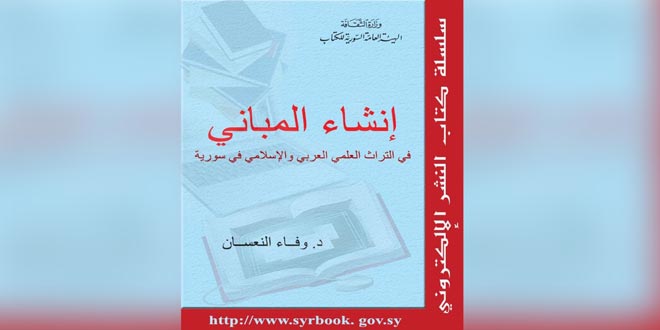Damascus-Sana
The newly released book titled “Building Buildings in the Arab and Islamic Scientific Heritage in Syria” is suitable for being an integrated scientific reference for students of engineering and architecture to study the foundations and shapes of ancient Syrian buildings and for researchers and those interested in heritage to find out the best ways to preserve and invest these buildings in a manner that does not affect their identity and originality.
The book, issued electronically by the Syrian General Book Organization, by Dr. Wafa Al-Na`asan, although it focuses on the structural aspects in these buildings, which some believe are less important than architecture and ornamentation, but it goes deep into the documentation of dozens of monuments that exist in Syria from the Stone Age to the Islamic, providing examples with pictures that make the book relevant Historical, archaeological, scientific, and architectural character.
Dr. Wafa explains in the introduction to the book that what led her to authoring her desire to shed light on heritage buildings from the construction point of view with the introduction of the historical, economic and political factors that surrounded them, indicating that she combined her viewing and personal inspection of these buildings with the dispersal of information scattered in books within a unified engineering framework and then Comparing the results with what is in reality through field surveys and documentation, overcoming several difficulties for this, the most important of which is the wide geographical area of research and the large number of heritage buildings in it.
The author begins her book from the diversity of building materials and construction methods in the Arab heritage, indicating that the Nabataeans and the Palmyrene used stones in building their homes and that the Arabs reached a great deal in structural engineering before and after Islam in a manner based on observation, experience and common sense, whether in the field of building materials or construction methods, which reflects efficiency. The scientific knowledge that the Arab engineer had in the field of building houses, palaces, forts, walls, castles, mosques, monasteries, dams and tunnels.
When Dr. Wafaa moved to talk about building materials and construction methods in heritage buildings in Syria, they were exposed to monoliths dating back to the Stone Age as caves carved into the rock in the village of Al-Bara, north of Aleppo. Then the Syrian moved to build houses from sun-dried milk on a stone basis, as in the village of Al-Maribet, referring to the development of construction in The Amorite ages, as we find it in the Mari and Canaanite civilizations, such as the Ebla civilization, where the use of clay and grilled tiles was common due to the scarcity of stones in those areas.
The author deals with building patterns in Ugarit, whose dwellings are characterized by the presence of several floors, the last floor of which is covered with a flat or slightly sloping roof, and the Syrian construction was influenced by the civilizations coming from Greek, Hellenistic and Roman in terms of chess city planning, roofing methods, building walls and raising columns.
Dr. Wafaa presents in her book an extensive research in an engineering study in ancient heritage buildings in the city of Aleppo from the Great Umayyad Mosque, the Al-Adliya Mosque and the Al-Iguni Al-Kamili Mosque, in addition to a similar study in the renovated heritage buildings, namely the Ajami kitchen and a bathhouse informing the Nasiri “Al-Lababidi” and Khan Al-Shouneh, then proceeds to talk about modern heritage buildings. In Aleppo, including the Baron Hotel and Al-Mamoun High School.
At the end of her book, the author presents recommendations calling for attention to and preservation of ancient Arab cities, especially since many of their buildings suffer from engineering problems, preserving the structural camels in heritage buildings, demonstrating their originality, preserving the quality of building materials used, and encouraging the residents living in these buildings and supporting them to carry out restoration operations. And alleviate the pressure of service activities in the old neighborhoods, which made them appear as if they are not homogeneous or consistent with the fabric of urbanization and construction of these areas.
It is noteworthy that the book is located in 424 pages of large pieces. As for the author, she was born in Aleppo, holds a degree in civil engineering and a doctorate in the history of applied sciences and archeology from the Institute of Arab Scientific Heritage at the University of Aleppo. She participated in more than 50 conferences and seminars locally, Arab and internationally.
Samer Al Shoghry

